
Among the sites visitors to Zurich are most likely to visit, Fraumünster, with its clock, tower stands tall. Many sightseers are church tourists who take a moment to visit churches famous for their architecture, stained glass, or as the site of famous historical events. Others come to Fraumünster specifically to view the painted glass windows created by Marc Chagall, and then leave. Or, they come to view the Chagall windows and remain to take in other famous sites in Fraumünster.
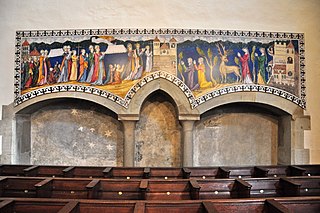
Fraumünster clerks charge visitors five Swiss francs to enter their domain, and supplies them with a very good recorded tour. The fee of five Swiss francs was my first interesting experience at Fraumünster. The Swiss don’t use the euro. In most places, patrons can pay in euros, but any change they receive will be in Swiss francs. Fraumünster does not accept euros. If a visitor does not have Swiss francs, the clerk accepts credit cards. Five Swiss francs is a little over five U.S. dollars, and the art and history at Fraumünster are worth the fee.
Fraumünster was once part of Fraumünster Abbey founded in A. D. 853. In 1272, the bones of the first two abbesses, Hildegard and Berta, were placed in the south wall of the church transept. About 1300, someone painted a fresco above their resting place. Someone painted over the original mural which was uncovered in 1847. Franz Hegi made a watercolor copy of the original in 2006.
The mural depicts the legends connected with the Fraumünster’s founding. If they seem a bit fanciful, remember the founding happened a very long time ago during the famous once upon a time . . .
Saints Felix & Regula
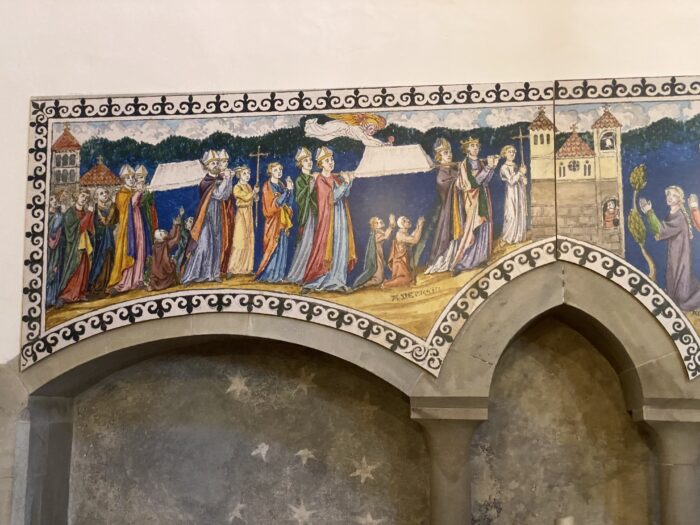
The left side of the mural tells the story of Felix and Regula. A procession moves from Grossmünster on the left edge of the picture to Fraumünster. Bishops and the king carry two coffins containing the bones of Saints Felix and Regula.
During the Third Century, Felix and his sister Regula were members of the Theban Legion. They had converted to Christianity and refused to sacrifice to the Roman Emperor Maximian. The emperor ordered them execution for treason. Felix and Regula fled with their servant Experantius, and reached Zurich where they were caught. In A. D. 286, the three fugitives were beheaded. But a curious thing happened. The three headless corpses stood, picked up their heads, walked forty paces uphill, prayed, and lay down on the spot that would become Grossmünster.
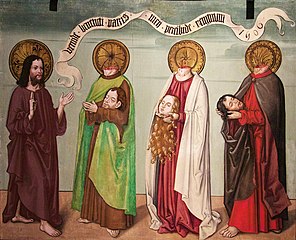
An alternative version of the story says that the Christian general Mauritius sent Felix, Regula, and their companions to wander to new places and serve God. When they arrived at the place where the river Limit left the lake, the wanderers set up their camp, and spent their days fasting, keeping vigils, and praying.
When Emperor Maximian heard of their activities, he sent Decius to force them to worship Roman gods. At first Decius could not find Felix and the others because God made them invisible. So, they asked God to make them visible to their enemies so they could enjoy being martyred and the happiness that would follow. Decius ordered the future saints to pray to the Roman gods. Felix, Regula and the others refused. Then the tortures began.
Stories of early Christian saints describe horrendous physical trials they experienced before achieving martyrdom. In this case, Decius ordered his men to attach the dissenters to red-hot iron wheels that were then plunged into boiling pitch. The Christians kept praying to God, so Decius made them drink molten lead. But still they persisted.
Finally a shining cloud appeared, and a voice promised that the dissenters would be received in heaven as saints. Decius ordered Felix, Regula, Experantius, and presumably their companions to be beheaded. A choir of angels and saints repeated the promise of their reception in heaven. Then, Felix, Regula and Experantius picked up their heads from the site of their execution by the banks of the Limit river, and carried them forty paces up the hill where the saints lay down. The site became a shrine of sorts where the blind and the lame reported miraculous cures.
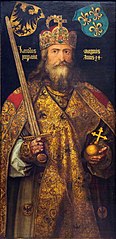
Many years later, Emperor Charlemagne was hunting a white stag. The hunters followed the stag to the site, where their dogs kneeled. The men returned to Charlemagne to tell their tale, and he followed them back to the site. When Charlemagne’s horse fell to its knees, the emperor knew he was in a holy spot. Immediately, he asked God what to do. Two hermits came to the king, and told him about the martyrs.
Charlemagne moved into a castle above Zurich and ordered his men to find the holy remains. When the remains were unearthed, they were elevated, canonized, and placed in tombs. Charlemagne moved the remains of Felix and Regula across the river to Fraumünster Abbey (see below). He took Exuperantius’s remains back to Aachen with him.
In A. D. 760, Grossmünster was complete. Charlemagne ordered the remains of Saints Felix & Regula returned to Grossmünster. Interestingly, Charlemagne did not return St Exuperantius’s remains, but replaced them with remains from a certain St. Placidus.
Princesses Hildegard & Bertha
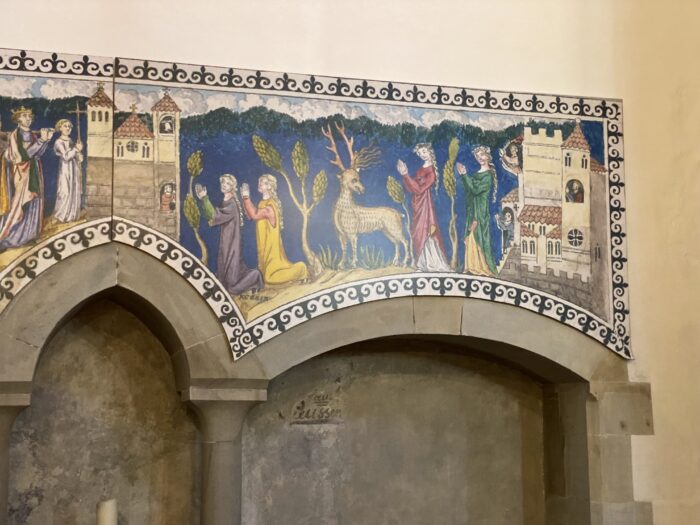
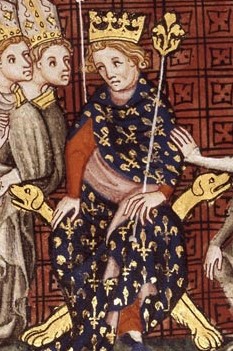
On the right side of the mural, the viewer sees a white stag with shining antlers leading the Princesses Hildegard and Berta, daughters of King Louis the German, from Balder Castle on the Albis river into Zurich to the spot where Fraumünster Abbey was built.
The legend explains that God sent the stag to the sisters to lead them to a meadow between the lake and the river where there was a chapel. After the princesses prayed, the stag accompanied the them back to their castle. This continued for some time until someone told the king that his daughters left castle at night, but no one knew where they went or what they did. After the king observed their activity, he asked them about their behavior. The young women replied they had taken a vow of chastity and did not want to live in the world. Where, then, would they choose to live? At the site where the river met the lake. And so, Louis built his daughters an abbey with a dedicated abbess, a space where noble women could join them, and room for seven canons. Princess Hildegard became the first abbess (853-856) and her sister Bertha, the second (857-877).
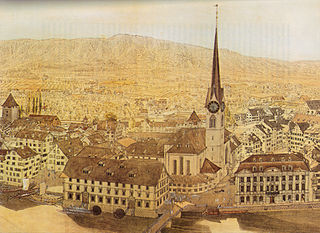
⛪️ ⛪️ ⛪️
Illustrations
Fraumünster Wall Painting by Roland zh.
Jesus facing Felix, Regula, and Experantius, 1506.
Emperor Charlemagne by Albert Dürer.
King Louis II the German.
Fraumünster Abbey in 1757.
All Other Photos by Author.
Joan A Holladay. “The Competition for Saints in Medieval Zurich.” Gesta. Vol. 43. No. 1. 2004. Pp 41-59.

Sandra Wagner-Wright holds the doctoral degree in history and taught women’s and global history at the University of Hawai`i. Sandra travels for her research, most recently to Salem, Massachusetts, the setting of her new Salem Stories series. She also enjoys traveling for new experiences. Recent trips include Antarctica and a river cruise on the Rhine from Amsterdam to Basel.
Sandra particularly likes writing about strong women who make a difference. She lives in Hilo, Hawai`i with her family and writes a blog relating to history, travel, and the idiosyncrasies of life.

